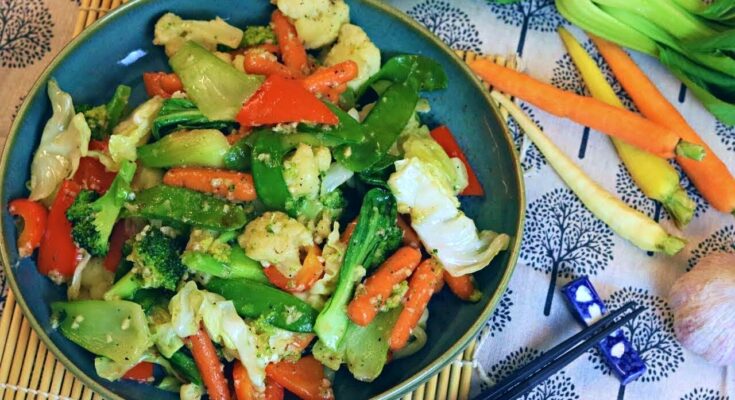Asian Stir Fry Recipe: Asian stir fry is more than just a quick weeknight dinner—it’s a celebration of bold flavors, fresh ingredients, and the magic of a sizzling hot wok. Whether you’re a seasoned home cook or just getting started in the kitchen, stir fry is one of those dishes that delivers maximum flavor with minimal effort. What makes it even better? It’s completely customizable. You can toss in whatever protein, veggies, and sauce you like, and boom—you’ve got yourself a healthy, colorful, and delicious meal in under 30 minutes.
Now, if you’ve ever wondered how restaurants get that perfect char and glossy finish, you’re not alone. The good news? With the right techniques (and I’ll walk you through them all), you can recreate that same magic right at home. This guide will take you step-by-step, from selecting the ingredients to plating your masterpiece.
Ready to stir things up? Let’s dive into this savory adventure.
What Makes Asian Stir Fry So Popular?
Asian stir fry is beloved around the globe for good reason. It’s quick, it’s tasty, and it’s ridiculously versatile. Think about it—you can go from raw ingredients to a finished meal in under 20 minutes. That’s faster than most takeout deliveries.
Beyond the convenience, there’s the flavor. The mix of savory soy sauce, umami-packed oyster sauce, a hint of sweetness from hoisin or sugar, and the depth from garlic and ginger—it’s like a flavor party in your mouth. And don’t forget the textures! The crunchy veggies, tender meat, and silky sauce all combine into one irresistible dish.
But what truly sets stir fry apart is its adaptability. Gluten-free? Use tamari. Vegan? Skip the meat and double up on tofu or mushrooms. Watching your carbs? Serve it without rice or noodles. Stir fry doesn’t judge—it just feeds you well.
Benefits of Making Stir Fry at Home
Let’s face it: homemade always wins. Sure, grabbing takeout might be easy, but when you cook stir fry at home, you’re in control. You know exactly what’s going into your food—no mysterious additives, no excess oil, and no sky-high sodium levels.
Here’s why it’s totally worth it:
- Healthier Ingredients: You choose fresh produce, lean meats, and quality sauces.
- Budget-Friendly: Stir fry stretches a few dollars into a hearty, satisfying meal.
- Customizable Flavors: Spicy? Mild? Sweet? It’s all up to you.
- Perfect for Meal Prep: Make a big batch and enjoy it over several days.
And honestly, there’s something really satisfying about tossing ingredients into a hot wok and watching them sizzle and steam like a pro chef.
Essential Ingredients You’ll Need
No stir fry is complete without a solid lineup of ingredients. Here’s what you’ll want to gather before you fire up that wok:
Protein Options
Pick one (or mix a few) depending on your preference:
- Chicken breast or thighs (thinly sliced)
- Beef (flank steak or sirloin work best)
- Shrimp or scallops
- Firm tofu or tempeh
- Pork (tenderloin or shoulder)
Marinate your protein with a little soy sauce, cornstarch, and sesame oil beforehand to boost flavor and ensure tenderness.
Vegetables
The more colorful, the better. Great options include:
- Bell peppers
- Broccoli
- Snap peas or snow peas
- Carrots (julienned)
- Mushrooms
- Baby corn
- Cabbage or bok choy
- Zucchini or yellow squash
- Onions
Pro tip: Slice everything thin and evenly for quick, uniform cooking.
Sauces & Oils
These give your stir fry that signature Asian flavor:
- Soy sauce (light or dark)
- Oyster sauce (for richness)
- Hoisin sauce (a touch of sweetness)
- Sesame oil (just a drizzle at the end)
- Rice vinegar or lime juice (for a bit of acid)
- Chili garlic sauce or Sriracha (if you like heat)
Aromatics & Seasonings
These form the backbone of your stir fry’s flavor:
- Garlic (minced)
- Ginger (freshly grated)
- Green onions (chopped)
- Crushed red pepper (optional)
- White or black pepper
- A pinch of sugar to balance flavors
Kitchen Tools You’ll Need
You don’t need a fancy kitchen to make an amazing stir fry. Just a few reliable tools:
- Wok or Large Skillet: The bigger, the better.
- Sharp Knife: For slicing those veggies thin and even.
- Cutting Board: Preferably two—one for meat, one for veggies.
- Tongs or Spatula: For tossing ingredients like a pro.
- Mixing Bowl: To prep your sauce and marinate your protein.
Having everything ready (called mise en place) is key. Once that pan gets hot, things move quickly.
Choosing the Right Wok or Pan
The wok is the unsung hero of the stir fry world. Its curved sides and high heat tolerance let you cook fast and evenly while keeping everything moving.
Here’s how to pick the right one:
- Material: Carbon steel is king—it heats fast and builds natural non-stick seasoning.
- Size: 12 to 14 inches is ideal for home use.
- Handle: A long handle is great for control; some also have a loop handle for balance.
If you don’t have a wok, a large stainless steel or cast iron skillet will work. Avoid non-stick pans—they can’t handle the high heat stir fry needs.
Step-by-Step Guide to Making Asian Stir Fry
Now the fun part—cooking! Let’s break it down step-by-step so you can make an epic stir fry every single time.
Step 1: Prep All Ingredients Before Cooking
Stir fry is a fast-cooking method, so preparation is key. You don’t want to be slicing carrots while your chicken’s already burning in the pan.
Do this first:
- Slice all veggies thin and evenly.
- Cut your protein into bite-sized pieces.
- Mince garlic and grate ginger.
- Mix up your stir fry sauce in a bowl.
Set everything within reach—you’ll thank yourself later.
Step 2: Make the Stir Fry Sauce
A killer sauce ties everything together. Here’s a classic base recipe (adjust to your taste):
Basic Stir Fry Sauce:
- 3 tbsp soy sauce
- 1 tbsp oyster sauce
- 1 tbsp hoisin sauce
- 1 tsp sesame oil
- 1 tbsp rice vinegar
- 1 tsp sugar
- 1 tbsp cornstarch
- ¼ cup water or chicken broth
Whisk everything together until smooth. The cornstarch thickens the sauce and gives it that glossy finish.
Step 3: Heat the Wok Properly
Crank the heat—stir fry is all about high heat, fast cooking. Add a tablespoon of oil (canola, vegetable, or peanut oil work best) and swirl to coat the pan.
Wait until the oil starts shimmering—that’s your cue to start cooking. Don’t let it smoke though!
Step 4: Cook the Protein
Toss in your marinated protein and spread it out in the wok. Let it sear undisturbed for 30 seconds to a minute—this gives you that golden crust. Then stir-fry until just cooked through and remove from the pan.
You’ll add it back later to avoid overcooking.
Step 5: Sauté the Aromatics
With the protein out, add a bit more oil if needed. Toss in garlic, ginger, and green onions. Stir for about 30 seconds until fragrant—don’t let them burn!
This step builds the flavor base of your stir fry.
Step 6: Add the Veggies
Now comes the color! Add your veggies in order of hardness—start with the firmest ones like carrots and broccoli, then finish with softer ones like mushrooms or spinach.
Cook just until crisp-tender. You want them bright and still a little crunchy.
Step 7: Add Sauce and Combine Everything
Pour in your sauce and give everything a good toss. Add your cooked protein back in. Stir constantly to coat everything evenly and let the sauce thicken.
This should take about 2 minutes. Once everything’s glossy and fragrant, it’s done!
Step 8: Optional – Add Cooked Noodles or Rice
Want to bulk it up? Add cooked rice or noodles directly to the pan. Lo mein, rice noodles, or even brown rice work great. Stir to coat everything in that delicious sauce.
Tips for Perfect Stir Fry Every Time
Even though stir fry is simple in concept, a few smart tips can elevate your dish from good to restaurant-quality. Want that iconic “wok hei” flavor—the smoky, savory depth that only comes from cooking over intense heat? Here’s how to level up your stir fry game:
- Don’t overcrowd the pan – This is the most common mistake. If the wok is too full, your ingredients will steam instead of sear. Cook in batches if needed.
- Use high heat – Stir fry is all about speed and sizzle. Medium-high to high heat helps caramelize proteins and veggies quickly.
- Dry your ingredients – Wet veggies or protein will release moisture and cause your stir fry to get soggy. Pat everything dry with paper towels before cooking.
- Slice everything evenly – Uniform slices help ensure everything cooks at the same pace.
- Use cornstarch in the sauce – It gives your stir fry that thick, glossy finish you see in restaurants.
- Finish with sesame oil or fresh herbs – A drizzle of sesame oil or a sprinkle of fresh cilantro or scallions at the end adds a burst of flavor and freshness.
These small techniques make a big difference and turn a basic stir fry into a mouthwatering masterpiece.
Best Veggies for Stir Fry
The beauty of stir fry is you can use nearly any vegetable in your fridge. But some work better than others due to their texture, cook time, and ability to absorb flavor. Here are the top veggies to consider for your next stir fry:
Top Stir Fry Vegetables:
- Bell Peppers – Sweet and crunchy, they bring vibrant color.
- Broccoli – Adds a nice bite and soaks up sauces beautifully.
- Snap Peas or Snow Peas – Quick cooking and naturally sweet.
- Carrots – Julienned or thinly sliced, they add color and crunch.
- Mushrooms – Earthy and juicy, great for a meaty texture.
- Baby Corn – A classic in Asian stir fry, mild and slightly sweet.
- Bok Choy – Tender and fresh with a bit of bite in the stalks.
- Zucchini – Soft and fast-cooking, ideal for a lighter dish.
- Green Beans – Blanch them first, then toss into the stir fry for crunch.
- Cabbage – Adds body and absorbs the sauce well.
Pro Tip: Avoid starchy veggies like potatoes—they don’t stir fry well and can weigh down the dish. For best results, keep your veggie mix to 3–5 types per stir fry to maintain balance.
Common Mistakes to Avoid
It’s easy to think stir fry is foolproof—but a few missteps can lead to soggy veggies, chewy meat, or bland sauce. Here’s what to watch out for:
- Cooking everything at once
Stir fry is fast, but that doesn’t mean throw it all in together. Cook protein first, remove, then cook veggies. Combine only at the end. - Low heat cooking
Medium heat doesn’t cut it. High heat is necessary to sear and caramelize. - Not prepping before cooking
Stir fry moves fast. You need everything chopped, measured, and ready to go before you turn on the burner. - Skipping the sauce thickener
Cornstarch not only thickens the sauce but helps it cling to the ingredients. Don’t leave it out. - Using the wrong oil
Butter or olive oil will smoke too fast. Use high-smoke-point oils like canola, peanut, or vegetable oil.
Avoid these mistakes, and your stir fry will taste just like your favorite takeout spot—if not better.
How to Store and Reheat Leftovers
Got leftovers? Lucky you! Stir fry stores surprisingly well and makes a perfect next-day lunch or dinner. Here’s how to do it right:
Storing Tips:
- Let the stir fry cool before refrigerating.
- Store in an airtight container.
- Use within 3–4 days for best taste and safety.
Reheating Tips:
- Stovetop (best method): Heat a splash of oil in a pan or wok over medium-high heat. Add stir fry and stir constantly until warmed through.
- Microwave: Use a microwave-safe dish, cover loosely, and heat in 30-second bursts. Stir in between.
- Avoid soggy veggies: Don’t reheat too long or your veggies will lose their crunch.
Want to freeze stir fry? It can be done, but keep in mind the texture of some veggies may change. Freeze in portioned containers, and thaw overnight before reheating.
Easy Variations of Stir Fry
Bored of the same old stir fry? You can switch things up endlessly. Here are some tasty variations to try next time:
Vegetarian Stir Fry
Skip the meat and go all in with the plants! Use tofu, tempeh, or even chickpeas for protein. Load up with mushrooms, edamame, and crunchy veggies. Add a splash of miso paste or tamari for extra umami.
Low-Carb Stir Fry
Watching carbs? Ditch the noodles and rice. Use cauliflower rice or just enjoy the stir fry as-is. Add more protein and non-starchy veggies like zucchini, broccoli, and cabbage.
Spicy Stir Fry
Love heat? Add sliced fresh chilies, chili garlic paste, or a drizzle of chili oil. Use Szechuan peppercorns for a numbing twist, or make a spicy Thai-style sauce with fish sauce, lime juice, and chili flakes.
What to Serve with Asian Stir Fry
While stir fry is a complete dish on its own, it pairs beautifully with a variety of sides to round out your meal.
Great Pairings:
- Steamed Jasmine Rice – Fluffy and perfect for soaking up the sauce.
- Fried Rice – For a more indulgent twist.
- Lo Mein or Rice Noodles – Stir in or serve on the side.
- Egg Rolls or Spring Rolls – Crispy and full of flavor.
- Hot and Sour Soup – A warm, tangy starter that complements the stir fry.
Looking to go low-carb? Try serving it with lettuce cups or roasted cauliflower.
Nutritional Value of Stir Fry
Stir fry can be a nutritional powerhouse when made right. Here’s a breakdown of what you get in a typical homemade chicken and vegetable stir fry:
| Nutrient | Approx. per serving (1.5 cups) |
|---|---|
| Calories | 300–400 kcal |
| Protein | 25–30g |
| Fat | 10–15g |
| Carbs | 20–30g |
| Fiber | 4–6g |
| Sodium | 700–900mg (depends on sauces) |
Want it healthier? Use low-sodium soy sauce, load up on veggies, and use lean proteins like chicken breast or tofu. Avoid bottled sauces high in sugar and salt.
FAQs about Asian Stir Fry Recipe
1. Can I use frozen vegetables in stir fry?
Yes! Just thaw and pat them dry first. They won’t be as crisp as fresh, but they’re super convenient and still tasty.
2. What’s the best oil for stir fry?
High-smoke-point oils like canola, peanut, sunflower, or avocado oil work best. Avoid olive oil—it burns too easily at high heat.
3. How do I make stir fry sauce thicker?
Add cornstarch! Mix 1 tablespoon cornstarch with 2 tablespoons water and stir into your sauce before adding it to the wok.
4. Can I make stir fry without a wok?
Absolutely. A large stainless steel or cast-iron skillet works fine. Just make sure it’s big enough to stir without crowding.
5. How do I keep stir fry veggies from going soggy?
Use high heat, don’t overcrowd the pan, and cook veggies just until crisp-tender. Also, dry them well before cooking.
Final Thoughts
Asian stir fry isn’t just a recipe—it’s a lifestyle choice for anyone who craves flavor, speed, and flexibility in the kitchen. It brings together everything we love about cooking: vibrant colors, mouthwatering aromas, sizzling sounds, and of course, incredible taste. Whether you’re cooking for yourself, a date night, or feeding a crowd, stir fry never fails to impress.
The beauty lies in its simplicity. Just a few fresh ingredients, a well-balanced sauce, and a hot pan—that’s all you need to create something magical. Don’t be afraid to experiment, try new combos, or add your own twist. Once you master the basic technique, the stir fry world is your oyster.
So the next time you open your fridge and wonder what to make for dinner, remember: stir fry is always the answer.



